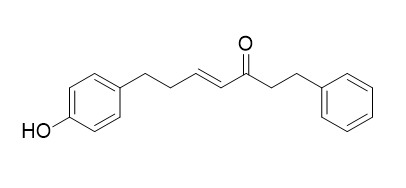7-(4-Hydroxyphenyl)-1-phenyl-4-hepten-3-one
7-(4-Hydroxyphenyl)-1-phenyl-4-hepten-3-one as a beneficial compound to ameliorate the deleterious effects of Aβ on dendrite integrity and cell survival, and may provide new insights on drug discovery of Alzheimer's disease (AD).
Inquire / Order:
manager@chemfaces.com
Technical Inquiries:
service@chemfaces.com
Tel:
+86-27-84237783
Fax:
+86-27-84254680
Address:
1 Building, No. 83, CheCheng Rd., Wuhan Economic and Technological Development Zone, Wuhan, Hubei 430056, PRC
Providing storage is as stated on the product vial and the vial is kept tightly sealed, the product can be stored for up to
24 months(2-8C).
Wherever possible, you should prepare and use solutions on the same day. However, if you need to make up stock solutions in advance, we recommend that you store the solution as aliquots in tightly sealed vials at -20C. Generally, these will be useable for up to two weeks. Before use, and prior to opening the vial we recommend that you allow your product to equilibrate to room temperature for at least 1 hour.
Need more advice on solubility, usage and handling? Please email to: service@chemfaces.com
The packaging of the product may have turned upside down during transportation, resulting in the natural compounds adhering to the neck or cap of the vial. take the vial out of its packaging and gently shake to let the compounds fall to the bottom of the vial. for liquid products, centrifuge at 200-500 RPM to gather the liquid at the bottom of the vial. try to avoid loss or contamination during handling.
Appl. Sci.2025, 15(1), 247
J Cell Mol Med.2023, 27(11):1592-1602.
Evid Based Complement Alternat Med.2016, 2016:4357656
Biomedicines.2021, 9(8):954.
J Chromatogr B Analyt Technol Biomed Life Sci.2020, 1149:122123.
Cell Biochem Funct.2018, 36(6):303-311
Tissue Cell.2022, 75:101728.
Front Nutr.2024, 11:1409309.
Journal of Ginseng Research2023, 12.004.
Evid Based Complement Alternat Med.2017, 2017:9764843
Related and Featured Products
Biol Pharm Bull. 2016 Dec 1;39(12):1961-1967.
7-(4-Hydroxyphenyl)-1-phenyl-4E-hepten-3-one, a Diarylheptanoid from Alpinia officinarum, Protects Neurons against Amyloid-β Induced Toxicity.[Pubmed:
27615431 ]
Amyloid-β (Aβ) is one of the major causative agents of Alzheimer's disease (AD), the most common neurodegenerative disorder characterized by progressive cognitive impairment. While effective drugs for AD are currently limited, identifying anti-Aβ compounds from natural products has been shown as a promising strategy which may lead to breakthroughs for new drug candidate discovery. We have previously reported that 7-(4-hydroxyphenyl)-1-phenyl-4E-hepten-3-one (7-(4-Hydroxyphenyl)-1-phenyl-4-hepten-3-one
,AO-1), a diarylheptanoid extracted from the plant Alpinia officinarum, has strong effects on neuronal differentiation and neurite outgrowth in vitro and in vivo.
METHODS AND RESULTS:
The present study further uncovers that AO-1 exerts neuroprotective effects against the neurotoxicity caused by Aβ. Under the damage of Aβ oligomers, the major pathological forms of Aβ, dendrites of neurons become atrophic and simplified, but such impairments were substantially alleviated by AO-1 treatment. Moreover, AO-1 reduced apoptotic levels and oxidative stress triggered by Aβ. Further analysis showed that the anti-caspase and dendrite protective effects of AO-1 were dependent on activation of phosphatidylinositol 3-kinase (PI3K)-mammalian target of rapamycin (mTOR) pathways.
CONCLUSIONS:
These findings collectively identify AO-1 as a beneficial compound to ameliorate the deleterious effects of Aβ on dendrite integrity and cell survival, and may provide new insights on drug discovery of AD.
Specioside B
Catalog No: CFN95165
CAS No: 126589-95-5
Price: $368/5mg
(1E)-3-methoxy-8,12-epoxygermacra-1,7,10,11-tetraen-6-one
Catalog No: CFN95219
CAS No: 1393342-06-7
Price: $413/5mg
Quercetin-3'-glucoside
Catalog No: CFN95271
CAS No: 19254-30-9
Price: $318/10mg
Peucenidin
Catalog No: CFN95272
CAS No: 33044-93-8
Price: $318/5mg
Batatasin V
Catalog No: CFN95320
CAS No: 65817-45-0
Price: $318/5mg
Dipsacus saponin X
Catalog No: CFN95359
CAS No: 146100-01-8
Price: $318/20mg
5,6,7,3',4',5'-Hexamethoxyflavanone
Catalog No: CFN95376
CAS No: 74064-17-8
Price: $318/10mg
1,3,4,6-Tetragalloylglucose
Catalog No: CFN95425
CAS No: 26922-99-6
Price: $318/10mg
Oxyphyllol B
Catalog No: CFN95575
CAS No: 226546-99-2
Price: Inquiry(manager@chemfaces.com)
N-Methyltetrahydrocolumbamine
Catalog No: CFN95590
CAS No: 92758-34-4
Price: $318/10mg



